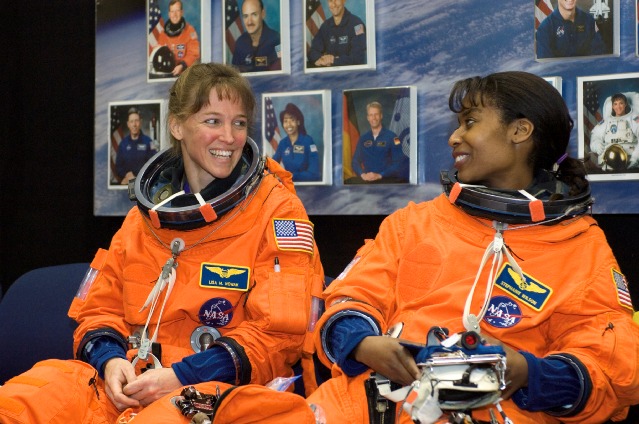President and Mrs. Bush Participate in Roundtable on the National Parks Centennial Initiative, FULL STREAMING VIDEO, Harry F. Byrd, Sr. Visitors Center, Shenandoah National Park, Luray, Virginia. Fact Sheet: The National Parks Centennial Initiative and In Focus: Environment 11:59 A.M. EST.
 | SECRETARY KEMPTHORNE: Mr. President, and First Lady Laura Bush, on behalf of all of the wonderful people of the National Parks Service, it is such an honor to have the First Couple here at this wonderful national park. |
And, ladies and gentlemen, those of you who are here at the roundtable, we look forward to this opportunity to have some discussions with you.
But we'd be very honored, Mr. President, just to get initial thoughts from you. As I introduce our President, let me just put it in this perspective: Two years ago, my wife, Patricia, and I had the great opportunity to spend three days with the President and the First Lady in Idaho, to see this couple, what the outdoors mean to them, how they recreate, how they replenish their energy. I just saw their connection. We went fishing, hiking, biking. I went home tired. (Laughter.) They went home with renewed energy.
MRS. BUSH: Refreshed.
SECRETARY KEMPTHORNE: And I think that you see that same sort of approach -- their love of the outdoors -- in this President's Centennial Challenge Initiative.
So, Mr. President, thank you for all you're doing.
THE PRESIDENT: One of the reasons I asked Dirk to be the Secretary of the Interior is because I knew that he knew how important parks are to the country. And I want to thank you and Mary for taking on your big jobs. Our national parks are really one of America's great treasures. And the fundamental question is, are we going to be wise enough to treat them as such?
When I first came into office, I was worried about a significant backlog of maintenance projects, and I want to thank Dirk for seeing through the completion or near completion of about 6,600 such projects.
And in our discussions, we talked about how to make sure the 100th anniversary of our parks, coming in 2016, really celebrates the National Park System. And so today we're going to talk about an initiative called the National Parks Centennial Initiative. And I'm looking forward to hearing from our fellow citizens about ways to make sure this initiative fully honors the Park System.
It is one thing to talk; it's another thing to act. And I've just submitted a budget to the United States Congress. In it we've got a billion dollars new money for operating expenses. And that really helps to honor those who work hard in our Park System. I really love being with our park rangers. These are dedicated people who have got a pretty cool job, when you think about it. (Laughter.) I just want to make sure that they got the money able to do their job.
As well, we look forward to having a public-private partnership. The federal government will match monies raised in the private sector up to a billion dollars. Our idea is to have $3 billion new money available for this important initiative. And I know that Dirk is going to work hard to make sure that people have their say as to how this money is spent.
And one person who has got a lot of say about the parks, in our family, is Laura. She is very much involved in our parks. She loves the outdoors. She takes a hike with her old high school buddies once a year to herald the Park System. If my entourage wasn't so big, I'd be with her. (Laughter.) But it's big. (Laughter.) So I stay at home.
But I really do appreciate Dirk and Mary and you all joining us. I'm looking forward to our discussion.
MRS. BUSH: Well, I just want to say how important the national parks are to me, personally important, because of all the times that I've had the opportunity to hike in our national parks, to camp in our national parks. I've traveled -- hiked every summer with a group of women that I grew up with in Midland. We all live in different parts of the country now, but we meet in a national park. We've mainly hiked in our big Western national parks: Yosemite; Yellowstone; Glacier; Olympic National Park; the Grand Canyon -- which we've done twice, once a Colorado River trip, and then hiking out the South Rim; the second time with our daughters, which was a lot harder than the first time, when we were a lot younger ourselves.
Our national parks -- the wildness of our national parks is one of the things I really like. Also, we live in a national park. The White House is considered a national park. The national parks include many of our most historical sites, the sites in our country that are shrines to our history. And that's also a very, very important part of the national parks.
But the part that I've loved is the wildness, the opportunity to be back, far back in the back country, where you don't see a lot of people, where you have a chance to birdwatch or do all the other things that we like to see -- you run into a bear every once in a while, which we have. Last summer we were in Denali, deep in Denali, in Alaska, and got to add to our life list of birds, a lot of birds that we wouldn't have ever had the chance to see if we hadn't been back deep in our wilderness.
So I want to congratulate Dirk. I want to thank President Bush for this major initiative for our national parks. It's very, very important for our country to make sure, as we come upon the centennial in 2016, that our national parks are treated with the respect that we want them to be treated with -- and it also gives us a chance to educate the stewards of our national parks that will come after us.
THE PRESIDENT: Thanks.
SECRETARY KEMPTHORNE: Mr. President and Laura, thanks very much for your opening comments. And we think about, in the 20th century, really one of the great figures was Theodore Roosevelt, who really convened the opportunities for America to focus on conservation and on our national parks. In the 21st century, Mr. President, I believe you have now caused America to focus on our national parks with this bold initiative.
This is something that is extremely well received by the National Park Service -- the excitement when we briefed them the last few days -- and then many groups that -- their advocation, their passion and dedication is to see that these national parks become all that they can for all the people to enjoy, and that the second 100 years are every bit as fantastic. So what you have done, Mr. President, you have infused such an energy with this budget that for the 21st century, this will be one of those hallmarks of your presidency. And I think Theodore Roosevelt would be very proud of you. (Laughter.)
With that, I'm going to introduce the other members at the roundtable. Mary Bomar, who is our National Park Service Director -- she is the first naturalized citizen in the United States to become director of the National Park Service. In just a moment, Mary I'll ask you for some comments.
Vin Cipolla, who is the President of the National Park Foundation. And he's been there for just a couple of years. And his leadership which he has brought to the foundation is just getting such high marks.
Derrick Crandall, who is the -- and I look at this -- the President and CEO of the American Recreation Coalition. He's been called, interestingly enough, the "recreation guru" by USA Today. He has been able to bring about organization of over 100 different entities that all believe in the outdoors, and his advocacy of the outdoors.
Gene Sykes, who is the Chairman of the National Parks Conservation Association. Gene is a managing partner of Goldman Sachs. I know if your love of the outdoors, the backpacking that you do repeatedly, and your particular love of the parks in Alaska.
Fred Andreae, who is a trustee, Shenandoah National Park Trust. Fred is one of these examples that, as you look at the 90 years of the National Park Service, the reason they have been able to achieve greatness is because of the partnership with philanthropic communities, with friends of the parks. And, Fred, you have established that here at Shenandoah Park. We truly appreciate that.
Chas Cartwright, who is the superintendent of this magnificent park. And you just say the name Shenandoah, and it's so historic and it conjures up so many great things. I also noted that in the '70s, you were a river ranger on the Salmon River in Idaho. (Laughter.)
MR. CARTWRIGHT: I remember it fondly.
SECRETARY KEMPTHORNE: Yes, I knew that we would bond. (Laughter.)
With that, let me turn to Mary Bomar for her comments.
DIRECTOR BOMAR: Thank you very much. Thank you, Secretary. Well, first of all, good afternoon to everybody. I met with Mrs. Bush yesterday. And again, it was so revitalizing. And your enthusiasm -- you are a true champion of our national parks, as is your husband, the President.
Thank you very much, first of all, for allowing me the opportunity to serve under this administration and be the 17th director of the National Park Service. But also, on behalf of the 20,000-plus men and women of the National Park Service in the gray and green out in these national treasures, thank you on their behalf.
I said again, you've seen Mrs. Bush often in the past with the junior ranger program. This budget will bring a renewed emphasis with a web ranger program that's going to be online. This puts 3,000 seasonal positions, the flat hats, gray and green, back out in the parks, on the trails. This budget will bring extended hours.
And we've listened to our superintendents when they've said to us, what do you need for your parks, and it is money and operations. This budget brings full fixed costs to the salaries for our employees. And I'm telling you, there is a great buzz going on in the national parks with our folks. But the bottom line is really to take care of the visitors in America. And what that budget does, bottom line is it puts our staff out in the parks to make sure that our visitors receive the very best experience.
The 2008 budget is not just about people, as I said, it's about -- tourism is very big to our parks, and we want to make sure they get the very best experience. And our National Park Service rangers, when they heard about 3,000 seasonals -- and, Chas, I know you will address that, what it does for this park alone. Some parks will have over 112, 115 seasonal rangers in maintenance, law enforcement, and interpretation now serving the public -- cleaner restrooms, cleaner beaches.
Our partners make a huge difference. The National Park Foundation with Vin Cipolla, and the people around this table and behind me. We work with our communities and our partners, and we couldn't do it without them.
I leave on a very simple note. I'm very honored to be the director leading the National Park Service. I have to thank this gentleman, the Secretary, on my right. He brings a wonderful vitality and energy and endless support, terrific advocate to the National Park Service. Thank you for all your hard work, working with the budget.
There are special places in America that unite us all as Americans, and Shenandoah is one of those special places. I am honored to be here today to represent the National Park Service. Thank you, President Bush, and thank you, Mrs. Bush.
SECRETARY KEMPTHORNE: Thank you, Mary.
Mr. President, you mentioned -- I thought this would be of note, because really it builds upon an initiative you started five years ago -- and the President referenced the 6,600 projects that were a backlog of deferred maintenance. Here they are. These are the projects. And it just shows you what has already been underway during these last five years. I mean, this is significant. Now we build upon this.
And this initiative which you have launched is not partisan; it is American. This is something that all of America can rally around, and I think this will be the reaffirmation of the parks being one of the greatest gifts to the American family.
Chas Cartwright, would you make a few comments please about the new perspective?
MR. CARTWRIGHT: I would be happy to. I'd like to welcome everybody to Shenandoah National Park -- beautiful, snowy -- (laughter) -- and just say that it's great to have such distinguished guests and everybody else here.
Shenandoah National Park has experienced a serious decline in visitation over the last 10 to 15 years. So I'm sure it comes as no surprise that our big job is how to connect and reconnect people with the park.
And we take very seriously our responsibilities as stewards of the money that we're given, and we've made the business decisions over the years to manage within our budget. But it's made that connection and reconnection effort more difficult. And what the Centennial Initiative does, it's going to get us there much faster. And it's needed, and it reflects an extremely high level of support from the President, from the Secretary, from you, Mary. And it's support for parks, and it's support for the men and women of the National Park Service, which is a great thing.
This funding for Shenandoah would mean $1.6 million -- $1 million in base funding, funding for seasonals, funding for a permanent volunteer coordinator. And we all know that volunteers are great, but it's much better when you have somebody that's directing those efforts. This would truly be a big deal for Shenandoah National Park. And it's something that, getting back to this reconnection piece, we really want to get new constituents out here to enjoy the park.
The Presidential Challenge piece will provide philanthropic partners like the Shenandoah National Park Trust and the park with some great opportunities for partnering. And we really look forward to work with organizations like the Shenandoah National Park Trust and surrounding communities in identifying projects that really get at key resource needs and improve the quality of the visitor experience.
So I just wanted to say, it's great having everybody here today. And thanks to the employees of Shenandoah National Park for doing such a great job.
THE PRESIDENT: Particularly the guy who cleared the road. (Laughter.) Listen, we want to thank you for your contributions here. We'll here from the other members here in a second. I do want to say something to follow up on this, and Congress needs to hear loud and clear how important this initiative is. And I fully hope the citizens groups who are concerned about the parks beat a hasty trail to the Congress and remind the Congress about what we have done and what we need to do as good stewards of the parks.
Anyway, thank you all.
END 12:10 P.M. EST. For Immediate Release, Office of the Press Secretary, February 7, 2007
Technorati Tags:
President Bush and
White House radio or
National Parks Centennial and
Shenandoah National Park or
First Lady Laura Bush and
SECRETARY KEMPTHORNE or
VIDEO

 . In Focus: Energy
. In Focus: Energy podnova Podcast Channel and receive the weekly Presidential Radio Address in English and Spanish with select State Department Briefings. Featuring real audio and full text transcripts, More content Sources added often so stay tuned.
podnova Podcast Channel and receive the weekly Presidential Radio Address in English and Spanish with select State Department Briefings. Featuring real audio and full text transcripts, More content Sources added often so stay tuned.




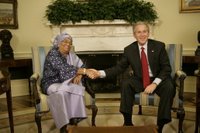
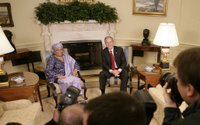
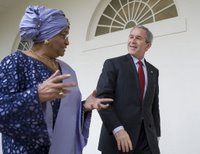
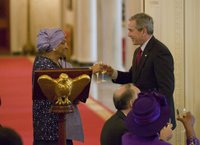
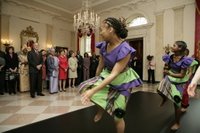
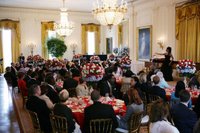
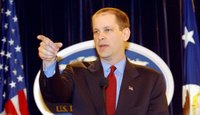
![Lebanese Internal Security Forces (ISF) cadets show off INL-provided civil disorder management equipment. [Photo courtesy U.S. Embassy Beirut, Lebanon]](https://blogger.googleusercontent.com/img/b/R29vZ2xl/AVvXsEiAUMx_aZ1ryh5r3IBzR3rAOHZl4sJicnUCswG5K1N9lBGyxgR7DMFarTCuZ3O6b5hctcGsBqZzjL-OaCy8zXvtyYlJObpcrqaYi1krJtDCNX-udY5QAgiETDjajisrpdupdjU1/s200/state_suv.jpg)






